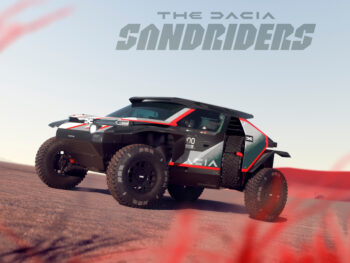Fantasy Fleet: Dacia Sandrider
Fancy a V6-powered Dakar Rally entrant for your fleet? John Challen ponders its business car merits.

Dacia will attempt the Dakar rally in 2025 with the Sandrider
Rally, to some people, will always be the poor relation to the glitzy and more glamorous world of Formula 1. But it’s also seen as really quite cool, so there’s no wonder manufacturers, when given the chance, love to get involved. Every year, without fail, Iveco talks up its latest Dakar Rally challenger, such is the excitement that vehicle generates within the truck industry and beyond.
On a much smaller scale, there’s now Dacia, which has unveiled the stunning Sandrider. Like Iveco, Dacia will be attempting the Dakar event in 2025, as well as competing in the World Rally-Raid Championship. Granted, there won’t be many similarities between the Sandrider and a mid-range Duster or Sandero. But, at the same time, the Renault-owned brand has the opportunity to win a new generation of fans (well, it worked for Mitsubishi and Subaru back in the day!).
Sandrider is inspired by Dacia’s Manifesto concept car and is using expertise from within Renault and Prodrive to create an agile, low-weight contender for the rally crown. Body panels are only used when utterly necessary, while the short, raked bonnet ensures optimum visibility for driver and co-pilot. The view from inside has also been taken into consideration on the upper part of the car’s dashboard, which features anti-reflective paint – an innovation taken from the world of aviation.
For its road cars, Dacia has worked hard to present a ‘go anywhere’ image, which is something that resonates – and is taken to the extreme – with the Sandrider. A consolidated subframe and bumpers sit alongside carbon bodywork, double wishbone suspension and a 4×4 transmission built for gruelling rally stages.
Beyond these stock fundamental elements, there are other handy innovations, such as safety belts that use antibacterial fabrics to self-regulate humidity – and uncovered spare wheels for improved accessibility. Reaching onboard tools is also made easier thanks to a magnetic plate built into the bodywork instead of a bolted panel – thereby reducing the risk of losing fixings in the sand.
Being 2024, there’s also an eco-friendly vibe to the Sandrider, with major efforts made to reduce mass and fuel consumption. The result is a vehicle that, according to Dacia, is “15kg lighter than comparable prototypes”. Clever aero work has ensured a 10% cut in drag and 40% drop in lift – at the same time ensuring more effective air inlets were used to cool the engine. Also keeping people and parts cool are infrared pigments directly integrated into the car’s carbon body – an innovation that is patent-pending.
If you want to keep up with how the Sandrider gets on, there’s a bit of a wait – a long testing programme is underway before the car’s debut at the Rally du Maroc 2024 in October. Then, the hard work begins in earnest in 2025, when the trio of rally legend Sébastian Loeb, Cristina Gutierrez Herrero and Nasser Al-Attiyah attempt the race series and the iconic Dakar race.
Dacia Sandrider
Price: Unknown
Engine: 3.0-litre V6 twin-turbo
Max power: 355hp Max torque: 539Nm
Body: Carbon fibre
Fuel: Synthetic
Suspension travel: 350mm
Tyres: 37-inch (BF Goodrich)
Likelihood of making it onto the fleet? 0.1/10













Leave a comment